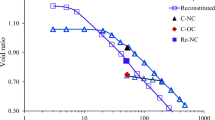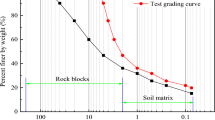Abstract
The aim of this paper is to provide an insight into the effect of fine content (FC) on the artificially cemented gravel-silty clay mixed soils (CMS) in terms of strength, deformation, effective stress path and pore pressure response by undrained cyclic triaxial tests. In addition, some cyclic triaxial tests were also conducted on remolded gravel-silty clay mixed soils (RMS) under the same test conditions in order to evaluate the effect of cementation provided by the cementitious material. The corresponding cyclic responses, such as the generation and accumulation of axial strain, pore pressure and effective stress path, are compared across a range of CMS and RMS. A constant 5% percentage (by weight) of calcium oxide in mixed soils with four different ratios of fine content (13%, 30%, 50% and 70%) are tested under four types of confining pressures, 50 kPa, 100 kPa, 200 kPa and 300 kPa respectively. The results demonstrate that: an increase in fine content leads to decrease in both strength and liquefaction resistance, but accelerate the strain accumulation and pore pressure development. The cyclic responses of CMS exhibit “hysteresis” significantly compared with those of RMS due to the bonding strength between soil particles.

















Similar content being viewed by others
References
Xu Q, Chen W, Zhang ZY (2008) New views on forming mechanism of deep overburden on river bed in southwest of China. Adv Earth Science 23(5):448–456 (in Chinese)
Sangrey DA (1972) Naturally cemented sensitive soils. Géotechnique 22(1):139–152
Burland JB (1990) On the compressibility and shear strength of natural clays. Géotechnique 40(3):329–378
Asghari E, Toll DG, Haeri SM (2003) Triaxial behaviour of a cemented gravely sand, Tehran alluvium. Geotech Geol Eng 21(1):1–28
Clough GW, Sitar N, Bachus RC et al (1981) Cemented sands under static loading. Int J Geotech Eng 107(6):799–817
Coop MR, Atkinson JH (1994) The mechanics of cemented carbonate sands. Géotechnique 44(3): 533~537
Haeri SM, Hamidi A, Hosseini SM et al (2006) Effect of cement type on the mechanical behavior of a gravely sand. Geotech Geol Eng 24(2):335–360
Dejong JT, Montoya BM, Boulanger RW (2013) Dynamic response of liquefiable sand improved by microbial-induced calcite precipitation. Géotechnique 63(4):302–312
Airey DW, Fahey M (1991) Cyclic response of calcareous soil from the north-west shelf of Australia. Géotechnique 41(1):101–121
Panico F, da Fonseca AV (2016) Long term cyclic response of a soil-cement mixture: experimental study and Modelling. Procedia Engineering 143:178–186
Wang WS (1980) Some findings in soil liquefaction. Chinese Jounal of Geotechnical Engineering 2(3):56–63 (in Chinese)
Kanıbir A, Ulusay R, Aydan Ö (2006) Assessment of liquefaction and lateral spreading on the shore of Lake Sapanca during the Kocaeli (Turkey) earthquake. Eng Geol 83(4):307–331
Hwang JH, Yang CW (2001) Verification of critical cyclic strength curve by Taiwan chi-chi earthquake data. Soil Dyn Earthq Eng 21(3):237–257
Lee DH, Ku CS, Yuan H (2004) A study of the liquefaction risk potential at Yuanlin, Taiwan. Eng Geol 71(1–2):97–117
Andrus RD (1994) In situ characterization of gravelly soils that liquefied in the 1983 Borah peak earthquake. Ph. D. Dissertation presented to the University of Texas at Austin
Evans MD, Zhou S (1995) Liquefaction behavior of sand-gravel composites. Int J Geotech Eng 121(3):287–298
Boulanger RW, Meyers MW, Mejia LH et al (1998) Behavior of a fine-grained soil during the Loma Prieta earthquake. Can Geotech J 35(1):146–158
Flora A, Lirer S, Silvestri F (2012) Undrained cyclic resistance of undisturbed gravelly soils. Soil Dyn Earthq Eng 43(4):366–379
Bezerra FHR, Fonseca VPD, Vita-Finzi C et al (2005) Liquefaction-induced structures in quaternary alluvial gravels and gravelly sediments, NE Brazil. Eng Geol 76(3):191–208
Chen L, Yuan X, Cao Z et al (2009) Liquefaction macrophenomena in the great. Wenchuan earthquake Earthquake Engineering and Engineering Vibration 8(2):219–229
Hou LQ, Li AF, Qiu ZM (2011) Characteristics of gravelly soil liquefaction in Wenchuan earthquake. Appl Mech Mater 90-93:1498–1502
Fan X, Westen CJV, Xu Q et al (2012) Analysis of landslide dams induced by the 2008 Wenchuan earthquake. J Asian Earth Sci 57(6):25–37
Lin P, Huang B, Li Q et al (2015) Hazard and seismic reinforcement analysis for typical large dams following the Wenchuan earthquake. Eng Geol 194:86–97
Turner LK, Collins FG (2013) Carbon dioxide equivalent (CO2-e) emissions: a comparison between geopolymer and OPC cement concrete. Constr Build Mater 43:125–130
Rao SN, Rajasekaran G (1994) Lime injection technique to improve the behaviour of soft marine clays. Ocean Eng 21(1):29–43
Marsal RJ (1967) Large scale testing of rockfill materials. Journal of the Soil Mechanics and Foundations Division 93(2):27–43
ASTM D5311(2011) test method for load controlled cyclic triaxial strength of soil. Annual book of ASTM standards. ASTM international, West Conshohocken
Thevanayagam S, Shenthan T, Mohan S et al (2002) Undrained fragility of Clean Sands, Silty Sands, and Sandy silts. J Geotech Geoenviron 128(10):849–859
Thevanayagam S, Martin GR (2002) Liquefaction in silty soils—screening and remediation issues. Soil Dyn Earthq Eng 22(9–12):1035–1042
Chang WJ, Hong ML (2008) Effects of clay content on liquefaction characteristics of gap-graded clayey sands. Soils Found 48(1):101–114
Ishihara K, Troncoso J, Kawase Y et al (1980) Cyclic strength characteristics of tailings materials. Soils Found 20(4):127–142
Xenaki VC, Athanasopoulos GA (2003) Liquefaction resistance of sand-silt mixtures: an experimental investigation of the effect of fines. Soil Dyn Earthq Eng 23(3):1–12
Gallagher PM, Mitchell JK (2002) Influence of colloidal silica grout on liquefaction potential and cyclic undrained behavior of loose sand. Soil Dyn Earthq Eng 22(9):1017–1026
Zhu-jiang S, Tie-lin C (2005) Breakage mechanics of geological materials-structural type and load sharing. Chinese journal of rock mechanics and Engineering 25(13): 2137–2142(in Chinese)
Schmertmann JH, Osterberg JO (1960) An experimental study of the development of cohesion and friction with axial strain in saturated cohesive soils. Research conference on shear strength of cohesive soils. ASCE, pp. 643–694
Saxena S, Tembhurkar AR (2020) Microbiological induced calcium carbonate process to enhance the properties of cement mortar. Materialstoday: proceedings 21(2):1350–1354
Shen ZJ (2006) Progress in binary medium modeling of geological materials. Modern Trends in Geomechancis, Springer, Berlin, Heidelberg, pp 77–99
Liu EL, Yu HS, Zhou C et al (2016) A binary-medium constitutive model for artificially structured soils based on the disturbed state concept and homogenization theory. Int J Geomech 17(7):04016154
Acknowledgements
The work is funded by National Science Foundation of China (NSFC) (Grant number 41790431), the CAS Pioneer Hundred Talents Program (Dr. Enlong Liu).
Author information
Authors and Affiliations
Corresponding author
Additional information
Publisher’s Note
Springer Nature remains neutral with regard to jurisdictional claims in published maps and institutional affiliations.
Electronic supplementary material
ESM 1
(DOCX 92 kb)
Rights and permissions
About this article
Cite this article
Yu, Hj., Liu, El. Cyclic Properties of Artificially Cemented Gravel-Silty Clay Mixed Soils. Exp Tech 44, 573–589 (2020). https://doi.org/10.1007/s40799-020-00376-7
Received:
Accepted:
Published:
Issue Date:
DOI: https://doi.org/10.1007/s40799-020-00376-7




